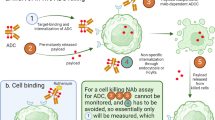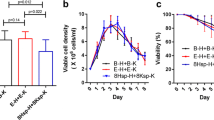Abstract
Affibody molecules constitute a novel class of molecular display selected affinity proteins based on non-immunoglobulin scaffold. Preclinical investigations and pilot clinical data have demonstrated that Affibody molecules provide high contrast imaging of tumor-associated molecular targets shortly after injection. The use of cysteine-containing peptide-based chelators at the C-terminus of recombinant Affibody molecules enabled site-specific labeling with the radionuclide 99mTc. Earlier studies have demonstrated that position, composition and the order of amino acids in peptide-based chelators influence labeling stability, cellular processing and biodistribution of Affibody molecules. To investigate the influence of the amino acid order, a series of anti-HER2 Affibody molecules, containing GSGC, GEGC and GKGC chelators have been prepared and characterized. The affinity to HER2, cellular processing of 99mTc-labeled Affibody molecules and their biodistribution were investigated. These properties were compared with that of the previously studied 99mTc-labeled Affibody molecules containing GGSC, GGEC and GGKC chelators. All variants displayed picomolar affinities to HER2. The substitution of a single amino acid in the chelator had an appreciable influence on the cellular processing of 99mTc. The biodistribution of all 99mTc-labeled Affibody molecules was in general comparable, with the main difference in uptake and retention of radioactivity in excretory organs. The hepatic accumulation of radioactivity was higher for the lysine-containing chelators and the renal retention of 99mTc was significantly affected by the amino acid composition of chelators. The order of amino acids influenced renal uptake of some conjugates at 1 h after injection, but the difference decreased at later time points. Such information can be helpful for the development of other scaffold protein-based imaging and therapeutic radiolabeled conjugates.




Similar content being viewed by others
References
Ahlgren S, Tolmachev V (2010) Radionuclide molecular imaging using Affibody molecules. Curr Pharm Biotechnol 11:581–589
Ahlgren S, Orlova A, Rosik D, Sandström M, Sjöberg A, Baastrup B, Widmark O, Fant G, Feldwisch J, Tolmachev V (2008) Evaluation of maleimide derivative of DOTA for site-specific labeling of recombinant Affibody molecules. Bioconjug Chem 19:235–243
Ahlgren S, Wållberg H, Tran TA, Widström C, Hjertman M, Abrahmsén L, Berndorff D, Dinkelborg LM, Cyr JE, Feldwisch J, Orlova A, Tolmachev V (2009) Targeting of HER2-expressing tumors using a site-specifically 99mTc-labeled recombinant Affibody molecule ZHER2:2395 with C-terminal engineered cysteine. J Nucl Med 50:781–789
Ahlgren S, Orlova A, Wållberg H, Hansson M, Sandström M, Lewsley R, Wennborg A, Abrahmsén L, Tolmachev V, Feldwisch J (2010a) Targeting of HER2-expressing tumors using 111In-ABY-025, a second generation Affibody molecule with a fundamentally re-engineered scaffold. J Nucl Med 51:1131–1138
Ahlgren S, Andersson K, Tolmachev V (2010b) Kit formulation for 99mTc-labeling of recombinant anti-HER2 Affibody molecules with a C-terminally engineered cysteine. Nucl Med Biol 37:539–546
Baum RP, Prasad V, Müller D, Schuchardt C, Orlova A, Wennborg A, Tolmachev V, Feldwisch J (2010) Molecular imaging of HER2-expressing malignant tumors in breast cancer patients using synthetic 111In- or 68Ga-labeled Affibody. J Nucl Med 51:892–897
Britz-Cunningham SH, Adelstein SJ (2003) Molecular targeting with radionuclides: state of the science. J Nucl Med 44:1945–1961
Cameron DA, Stein S (2008) Drug insight: intracellular inhibitors of HER2—clinical development of lapatinib in breast cancer. Nat Clin Pract Oncol 5:512–520
Chang HR (2010) Trastuzumab-based neoadjuvant therapy in patients with HER2-positive breast cancer. Cancer 116:2856–2867
Citri A, Yarden Y (2006) EGF-ERBB signalling: towards the systems level. Nat Rev Mol Cell Biol 7:505–516
Ekblad T, Tran T, Orlova A et al (2008) Development and preclinical characterisation of 99mTc-labelled Affibody molecules with reduced renal uptake. Eur J Nucl Med Mol Imaging 35:2245–2255
Ekblad T, Orlova A, Feldwisch J, Wennborg A, Eriksson Karlström A, Tolmachev V (2009) Positioning of 99mTc-chelators influences radiolabeling, stability and biodistribution of Affibody molecules. Bioorg Med Chem Lett 19:3912–3914
Engfeldt T, Orlova A, Tran T et al (2007a) Imaging of HER2-expressing tumours using a synthetic Affibody molecule containing the 99mTc-chelating mercaptoacetyl-glycyl-glycyl-glycyl (MAG3) sequence. Eur J Nucl Med Mol Imaging 34:722–733
Engfeldt T, Tran T, Orlova A, Widström Ch, Eriksson Karlström A, Tolmachev V (2007b) 99mTc-chelator engineering to improve tumour targeting properties of a HER2-specific Affibody molecule. Eur J Nucl Med Mol Imaging 34:1843–1853
Hynes NE, MacDonald G (2009) ErbB receptors and signaling pathways in cancer. Curr Opin Cell Biol 21:177–184
Löfblom J, Feldwisch J, Tolmachev V, Carlsson J, Ståhl S, Frejd FY (2010) Affibody molecules: engineered proteins for therapeutic, diagnostic and biotechnological applications. FEBS Lett 584:2670–2680
Mankoff DA (2009) Molecular imaging to select cancer therapy and evaluate treatment response. Q J Nucl Med Mol Imaging 53:181–192
Miao Z, Levi J, Cheng Z (2010) Protein scaffold-based molecular probes for cancer molecular imaging. Amino Acids. doi:10.1007/s00726-010-0503-9
Nygren PA (2008) Alternative binding proteins: affibody binding proteins developed from a small three-helix bundle scaffold. FEBS J 275:2668–2676
Orlova A, Tolmachev V, Pehrson R, Lindborg M, Tran T, Sandström M, Nilsson FY, Wennborg A, Abrahmsén L, Feldwisch J (2007) Synthetic affibody molecules: a novel class of affinity ligands for molecular imaging of HER2-expressing malignant tumors. Cancer Res 67:2178–2186
Orlova A, Magnusson M, Eriksson T, Nilsson M, Larsson B, Höiden-Guthenberg I, Widström C, Carlsson J, Tolmachev V, Ståhl S, Nilsson F (2006) Tumor imaging using a picomolar affinity HER2 binding Affibody molecule. Cancer Res 66:4339–4348
Tolmachev V (2008) Imaging of HER-2 overexpression in tumors for guiding therapy. Curr Pharm Des 14:2999–3011
Tolmachev V, Nilsson FY, Widström C, Andersson K, Rosik D, Gedda L, Wennborg A, Orlova A (2006) 111In-benzyl-DTPA-ZHER2:342, an affibody-based conjugate for in vivo imaging of HER2 expression in malignant tumors. J Nucl Med 47:846–853
Tolmachev V, Stone-Elander S, Orlova A (2010a) Current approaches to the use of radiolabeled tyrosine kinase-targeting drugs for patient stratification and treatment response monitoring: prospects and pitfalls. Lancet Oncol 11:992–1000
Tolmachev V, Hofström C, Malmberg J et al (2010b) HEHEHE-tagged affibody molecule may be purified by IMAC, is conveniently labeled with [99(m)Tc(CO)3](+), and shows improved biodistribution with reduced hepatic radioactivity accumulation. Bioconjug Chem 21:2013–2022
Tolmachev V, Velikyan I, Sandström M, Orlova A (2010c) A HER2-binding Affibody molecule labelled with 68Ga for PET imaging: direct in vivo comparison with the 111In-labelled analogue. Eur J Nucl Med Mol Imaging 37:1356–1367
Tran T, Engfeldt T, Orlova A et al (2007a) In vivo evaluation of cysteine-based chelators for attachment of 99mTc to tumor-targeting Affibody molecules. Biocojug Chem 18:549–558
Tran T, Engfeldt T, Orlova A et al (2007b) 99mTc-maEEE-ZHER2:342, an Affibody molecule-based tracer for detection of HER2-expression in malignant tumors. Bioconjug Chem 18:1956–1964
Tran T, Ekblad T, Orlova A et al (2008) Effects of Lysine-containing mercaptoacetyl-based Chelators on the Biodistribution of 99mTc-labeled anti-HER2. Bioconjug Chem 19:2568–2576
Tran TA, Rosik D, Abrahmsén L et al (2009) Design, synthesis and biological evaluation of a HER2-specific affibody molecule for molecular imaging. Eur J Nucl Med Mol Imaging 36:1864–1873
Wållberg H, Orlova A (2008) Slow internalization of anti-HER2 synthetic affibody monomer 111In-DOTA-ZHER2:342-pep2: implications for development of labeled tracers. Cancer Biother Radiopharm 23:435–442
Wållberg H, Ahlgren S, Widström C, Orlova A (2010) Evaluation of the radiocobalt-labeled [MMA-DOTA-Cys61]-Z HER2:2395(-Cys) affibody molecule for targeting of HER2-expressing tumors. Mol Imaging Biol 12:54–62
Wållberg H, Orlova A, Altai M, Widström C, Hosseinimehr SJ, Malmberg J, Ståhl S, Tolmachev V (2011a) Molecular design and optimization of 99mTc-labeled recombinant affibody molecules improves their biodistribution and imaging properties. J Nucl Med 52:461–469
Wållberg H, Löfdahl PÅ, Tschapalda K, Uhlén M, Tolmachev V, Nygren PÅ, Ståhl S (2011b) Affinity recovery of eight HER2-binding affibody variants using an anti-idiotypic affibody ligand. Protein Exp Purif 76:127–135
Acknowledgments
This research was financially supported by grants from the Swedish Cancer Society (Cancerfonden) and the Swedish Research Council (Vetenskapsrådet).
Author information
Authors and Affiliations
Corresponding author
Rights and permissions
About this article
Cite this article
Altai, M., Wållberg, H., Orlova, A. et al. Order of amino acids in C-terminal cysteine-containing peptide-based chelators influences cellular processing and biodistribution of 99mTc-labeled recombinant Affibody molecules. Amino Acids 42, 1975–1985 (2012). https://doi.org/10.1007/s00726-011-0927-x
Received:
Accepted:
Published:
Issue Date:
DOI: https://doi.org/10.1007/s00726-011-0927-x




